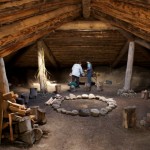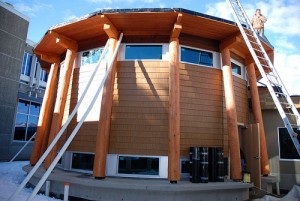Aboriginal Gathering Places
To support an inquiry project that our district is about to begin, I investigated possible meeting sites for the education stakeholders that will come together in learning and understanding. I was hoping to locate sites other than school district property where all participants could come together.
Three (at least) such sites are within access of our group. To date I have visited two of the sites.
The first is the Mir Centre for Peace. The Doukobors began migrating to the area in 1908. At that time the land was home to First Nations peoples and European settlers. The relationship between the Doukobors and local First Nations were not always peaceful. Land beside Selkirk College was given to the college and late in the 20th Century the idea of the Mir (peace, community, and world) Centre was born. The site was to see the restoration of one of the few remaining Doukobor buildings and space set aside on the land for First Nations Ceremony and Structure.
 The second site that I visited was the Sinixt pit house located in the Slocan valley. Radio carbon dating suggests that the pit house was occupied as early as 3000 years ago and as recently as 200 years ago. In 1987 artifacts, skeletal remains and pit house depressions were discovered when the Ministry of Highways began road construction in the Slocan Valley. Through great restoration efforts the pit house is now an awesome place to visit and in which to learn and reflect. Click on the image of Marylin James to see a short video on the pit house restoration project.
The second site that I visited was the Sinixt pit house located in the Slocan valley. Radio carbon dating suggests that the pit house was occupied as early as 3000 years ago and as recently as 200 years ago. In 1987 artifacts, skeletal remains and pit house depressions were discovered when the Ministry of Highways began road construction in the Slocan Valley. Through great restoration efforts the pit house is now an awesome place to visit and in which to learn and reflect. Click on the image of Marylin James to see a short video on the pit house restoration project.
The third and final site is the Selkirk College Aboriginal Gathering Place. Next on my list for a visit.
Wilkinson, M. (2006, Fall). Mir centre for peace at selkirk college:understanding and building cultures of peace. Retrieved from http://selkirk.ca/media/innovation/mircentreforpeace/history/MIR-History—-Myler’s-09-02-25.pdf



0 comments
Kick things off by filling out the form below.
You must log in to post a comment.